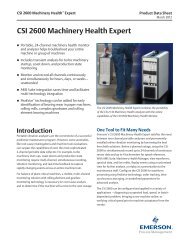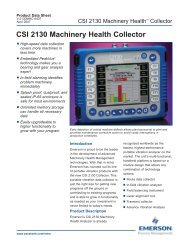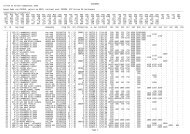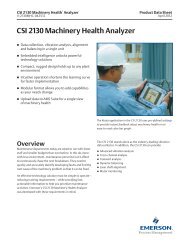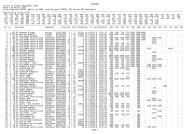Download Publication - The Nuffield Trust
Download Publication - The Nuffield Trust
Download Publication - The Nuffield Trust
You also want an ePaper? Increase the reach of your titles
YUMPU automatically turns print PDFs into web optimized ePapers that Google loves.
January 2011others, 2004; Gleave, 2009; Ham, 2010a). <strong>The</strong>y have shownthat it is possible to build integrated care systems with a strongprimary care base that place a major emphasis on quality,prevention and minimising use of expensive hospital-basedcare. <strong>The</strong>se organisations are still relatively rare and othermodels are being explored for funders to achieve the sameresults, for example ‘accountable care organisations’ wherehealthcare organisations and medical groups cooperate to takeon a fixed budget with which to commission outcome-basedcare for a population (Orszag and Emanuel, 2010).<strong>The</strong> allocation of fixed budgets to medical groups as analternative to fee-for-service practice is not a new idea(Shortell and Casalino, 2008). In a few areas in the US,including California, groups have been using fixed budgetsto provide primary and specialist care for more than twodecades. It is their experience of assuming and managingthese budgets, together with the associated financial andservice risk, that is of interest as potential learning for theNHS (Ham, 2010b; Casalino, forthcoming).Medical groups and independentpractitioner associations<strong>The</strong>re are two main variants of these medical groups in theUS: medical groups and independent practitioner associationsBox 1: Two kinds of medical groupMedical groups: <strong>The</strong>se groups employ their memberdoctors, who typically work in clinics owned by themedical group, or as hospitalists, working for the groupin local hospitals. Doctors – many of them specialists –are salaried and usually receive a bonus for providinghigh-quality care in line with agreed standards andguidelines. <strong>The</strong>se groups have some similarities to largeEnglish group practices, although US medical groupsgenerally include GPs and specialists.Independent practitioner associations (IPAs): IPAsformed as corporate structures through whichphysicians could come together to negotiate andadminister health maintenance organisation (HMO)contracts on behalf of their members (Robinson andCasalino, 1996). IPAs are networks of doctors whocontinue to own and run their own clinics, but who joinan IPA to get access to contracts while also obtainingadministrative and technical support.Many organisations – including the case studiesoutlined in this document – combine features of amedical group with an IPA model.(IPAs) (see Box 1). <strong>The</strong>se are generally multi-specialty,combining primary care doctors with specialists.Most of these groups were formed from the late 1980s afterlegal changes allowed them access to the ‘managed caremovement’ in the US. Health maintenance organisations(HMOs) were generally owned by insurance companiesthat used the techniques of managed care to control costs.<strong>The</strong>se included using primary care as a gate-keeper tospecialist care, and trying to reduce the use of unnecessaryhospital services by intensive management of patients withchronic illness and complex needs.In many areas, HMOs coordinated patients’ carethemselves and gave capitated budgets to individualprimary care doctors for general practice services. But inother areas, doctors came together in groups and IPAs tocontract with the HMOs and take on responsibility formanaging and coordinating care across a wider range ofservices. Up to 2,000 of these groups took root across theUS in the late 1980s. However, many failed to managerisk-bearing budgets successfully (Casalino, forthcoming).In California, medical groups were particularly prevalentand some have proved to be long-lived. This peculiarity ofCalifornia is perhaps due to the success of KaiserPermanente and its associated Medical Group, which actedas a powerful stimulant for the HMO industry in California(Robinson, 2001). As large insurers mounted a competitiveresponse to Kaiser, they sought out multi-specialty medicalgroups rather than building networks of small practicesthemselves. Offering fixed budgets to these groups, theytransferred insurance risk by requiring them to manage arange of health care services within an agreed budget, andto specified quality standards.In the 1980s, as these groups were forming, the financialenvironment was favourable and they were often able tonegotiate progressively larger annual budgets withinsurers, while the public was initially tolerant of thedrive to control costs through the techniques of managedcare (Robinson, 2001). During this time, many of theCalifornia groups proved that they could reducehospital admissions amongst their patients to wellbelow national averages (Robinson and Casalino, 1995).A leaner period followed in the 1990s, as growth inannual budgets flattened or declined, driven partly byconsumers and employers losing their appetite formanaged care (perceiving it as a way of reducingchoice and limiting access to services). Some medicalgroups and IPAs went bankrupt, others merged intolarger groups and many abandoned risk contractingwww.nuffieldtrust.org.uk/publications 3
GP commissioning: insights from medical groups in the United States(Casalino, forthcoming). <strong>The</strong> public’s hostility to managedcare has persisted – doctors are wary of being seen to denycare on the grounds of cost.Those medical groups and IPAs that have survivedare generally associated with higher-quality care, asevidenced by greater adherence to clinical guidelines andadoption of electronic medical records (Shortell andCasalino, 2008).Case studiesWe chose our case studies from variants of the two typesof groups described in Box 1. Details of the four groupsselected for study are set out below, in Table 1. We aimedto generate a sample with a variety of size and ownershipmodels. <strong>The</strong> organisations include both profit andnon-profit status.In each organisation, we interviewed senior managers(clinicians and non-clinicians) and doctors who weremembers of the group or IPA. As can be seen fromTable 1, the groups vary in size and form, but whatunites them is that they all manage fixed budgets for anenrolled patient population.<strong>The</strong> groups negotiate annually with the health plans(insurers) for a ‘capitated’ budget, which is paid monthlyto the group (see Figure 1). This budget is calculated as afixed amount per head of population enrolled with thegroup (capitation), adjusted for age and sex and, in thecase of Medicare patients (the over-65 age group fundedby the federal government for their care), on the severityof existing health conditions. A single medical group orIPA will typically hold contracts with several health plans.Budgets are paid monthly to the groups, from which theypay their doctors and a range of other service providers,including hospitals and diagnostic services. It should benoted that the medical groups do not rely solely onbusiness from capitated patients but also provide servicesfor patients with different kinds of insurance products,which have in recent years been growing in popularityrelative to fixed-budget insurance.Limitations of our research<strong>The</strong>re are two main limitations of this research. <strong>The</strong> firstconcerns the US context – these groups are notresponsible for the health of all patients in theirgeographical area in the way that GP consortia will be.In addition, they are not required to involve patients orcommunities in the design and delivery of services, as weassume will be the case with GP consortia in the NHS.Patients are primarily seen as consumers in the UShealthcare system, and are able to exercise choice byswitching health plans or doctor, although in practicechoice is often heavily curtailed by income or type ofhealth plan.Table 1: Characteristics of case studiesNameDateformedTypeCapitatedpatientsNumber of GPsSpecialistsTotal employeddoctorsBristol ParkMedicalGroup1961Group +IPA forspecialists68,00089 employed700 contracted,6 employed95HealthCarePartners1992Group + IPA650,000(3 states)1,400 contracted,480 employed2,600 contracted,120 employed600MonarchHealthCare1994IPA + employeddoctors170,000800 contracted,6 employed1,200 contracted,27 employed33Mills-PeninsulaMedical Group1994IPA + employeddoctors45,000112 contracted,26 employed254 contracted,9 employed354www.nuffieldtrust.org.uk/publications
January 2011Figure 1: Financial flows within IPAs and medical groupsInsurance companies$$ $Capitation feenegotiated annually,paid monthlyMedical group or IPAPrimarycareDrugsSpecialistsHospitalsImagingGroups use a combination of salaries, bonuses and fee-for-serviceto pay doctors, either employed or on contractGroups take riskfor some or all ofthese servicesSecond, these groups are survivors of an intense process ofevolution, particularly through the difficult financialenvironment of the late 1990s. It is tempting to view theirattributes – as expressed by their leadership – as the soledeterminants of success. It is however possible that thereare wider contextual reasons why some groups succeeded,which were beyond the scope of this study to explore.Case study findingsIn this section we summarise the key findings from ourvisits to the four medical groups, including theircharacteristics, functions and achievements. This isfollowed by an exploration of the main themes thatemerged from our analysis of the groups and the learningoffered for GP commissioning in the NHS.Summary points• All four groups are owned and led by doctors. <strong>The</strong> groupshave evolved over several decades and have enjoyedsubstantial continuity of leadership over this period.• <strong>The</strong> groups have varying forms of ownershiparrangements, including full shareholding for someor all doctors, and varying governance structureswhich aim to enable engagement with memberphysicians.• <strong>The</strong> number of enrolled patients ranges from 45,000to over 650,000 patients. Larger size minimisesfinancial risk, but creates greater leadership andmanagement challenges.• <strong>The</strong> groups negotiate risk-bearing budgets for a widerange of services, but can also negotiate to hand backcoverage to insurance companies (who then organisethese services for patients) where they do not feelable to control an area of financial risk. This flexibilityhas been important to the some of the groups’financial survival.• All groups see themselves as businesses, in whichsuccess hinges on delivering high-quality care at acost lower than the commissioning budget. A keyleadership skill involves reconciling business goalswww.nuffieldtrust.org.uk/publications 5
GP commissioning: insights from medical groups in the United Stateswith clinical quality and doctors’ autonomy, thusavoiding perceptions of care being denied to patientson cost grounds.• Savings are made from efficient provision of high-qualitycare, by managing chronic disease, avoiding unnecessaryhospital admissions and minimising readmissions.Groups monitor referrals into specialist care and requireprior authorisation for some procedures.• Success is built on high-quality primary care, andall groups closely performance manage their primarycare doctors by feeding back data on performanceand using financial incentives linked to qualityindicators.• Success also depends on judicious use of specialist careby the groups’ doctors. All the groups have specialists aspart of their membership (either employed or oncontract) and ‘hospitalists’ to manage their patients’ carewhen in hospital.• Groups have either developed, or contracted with,alternatives to hospital care, including skilled nursingfacilities, urgent care centres and 24-hour support fortheir most frail patients.• <strong>The</strong>re has been substantial investment in data collection,IT systems and analysts, and in professional staff tonegotiate contracts, organise billing and managedoctors’ performance.Emerging themesClinical ownershipAll groups described themselves as ‘physician-owned’,but there were different forms of ownership. In theIPA model (where doctors own their premises, similarto GPs), doctors could belong to several IPAs at once,so the two IPAs (Monarch HealthCare andMills-Peninsula Medical Group) open the offer ofshareholding to all their doctors with a significantcontractual relationship with the group. For the twoemployed medical groups, a tiered approach toownership was used. For example, one group assignednew recruits to an initial period of purely salariedemployment, followed by the opportunity to become apartner or a shareholder. Partnership brought increasingfinancial benefits but also meant that a greater proportionof a doctor’s income was tied to performance. In additionto shareholding or partnership, doctors were givenopportunities to own stakes in capital projects.Although there was some variation, a common theme inthe interviews was the importance of building a sense ofownership and belonging among the member doctors.“It’s owned by physicians and governed byphysicians. It’s a concept which is reallyimportant to our success.”Medical director, medical groupA sense of ownership was perceived as important because itenabled the group to take decisions about investment ormeasures to improve the quality of care in the confidencethat all (or many) of its doctors would cooperate actively.One group, Bristol Park, allowed all doctors access tomonthly board meetings (which were very well attended),and had a smaller executive committee that was able to takedecisions more swiftly. This committee combined executiveofficers and board members (the overall governancearrangements for Bristol Park are set out in Figure 2).Leaders in all groups described a fine line betweenphysician ownership and ‘excessive democracy’, whererank-and-file doctors could be overly influential onexecutive decisions. It was felt to be very important to havean executive board (or equivalent) that was mandated totake decisions in the interests of the group, on behalf of thewider membership.Strength and longevity of leadershipInterviewees were unequivocal in asserting the importanceof sustained and stable medical leadership of theorganisation. <strong>The</strong>y were clear that their groups had thrivedbecause they were run as businesses, and felt that theirsuccess was rooted in an ability to negotiate adequatecapitated rates with insurance companies and then delivercare at a lower cost than the budget.To do this, groups needed to negotiate contracts withspecialists and hospitals, and to manage the performanceof their doctors so that they are able to deliverhigh-quality primary care. Medical leadership wasconsidered crucial to these functions – for example, toencourage primary care doctors to make appropriate useof specialist care and use services developed as alternativesto hospital admission.“Having physician leaders makes a bigdifference. Deep down you know they’vewalked in your shoes, so there’s more trust.Doctor, IPA6www.nuffieldtrust.org.uk/publications
January 2011Figure 2: Governance structure of Bristol Park Medical GroupShareholder doctors’ membershipAvailable to doctorsafter two yearsof salaried employmentShareholders electboard annuallyMonthly boardmeetings opento all membersBoard (17)Board delegates someresponsibilities to executivecommittee; meets bi-monthlyExecutivecommittee (7)CommitteesSenior managementteamReports to BoardAll doctors are encouraged to participate in doctor-ledcommittees on various aspects of patient care and quality,within 10 regional offices<strong>The</strong> experience of doctors leading colleagues throughthe hard economic times of the late 1990s was centralto the story of each organisation. Some of the groupshad experienced consecutive years with minimal ornegative growth in doctors’ income, and believed thatclinical leaders had the ability to retain the confidenceof doctors in these lean times where lay managerswould have failed.For other aspects of medical group business, it wasreported as being very important to understand whenprofessional managers and leaders were needed. <strong>The</strong>leaders of one of the IPAs considered that their fortuneshad been saved by the decision to hire professionalmanagers after the founding doctors becameout of their depth and ill-equipped to discharge theroles for which they had volunteered. With hindsight,the recruitment of non-doctors had been an essentialstep, but at the time it was perceived negativelyby doctors.“It was very challenging because doctors liketo control everything. But we had to realisethat physicians would be more successful inpartnership with non-physicians. That’s a verydifficult step for physicians to take.”CEO, IPAIt was notable that amongst the leaders we interviewed,many were founder members and had been in post forat least one, sometimes two, decades. Continuity ofleadership was clearly perceived to be a virtue, and anemphasis was also placed on the need to identify andnurture future leaders, although this was acknowledgedto be challenging in practice. Encouraging activeparticipation through committees was one way ofbuilding a cadre of future leaders, particularly wherecommittees handle core topics, such as setting standardsfor quality improvement. Some of the groups felt thatwww.nuffieldtrust.org.uk/publications 7
GP commissioning: insights from medical groups in the United Statesmore energy should be spent on building future leadersand regarded the involvement of more women who oftenwanted to work part-time as a challenge that had not yetbeen fully addressed.Engagement of doctorsPhysician leaders invested considerable amounts of timein developing and maintaining relationships withrank-and-file doctors. <strong>The</strong>re was a range of opportunitiesfor doctors to be involved in governance of the group,for example attendance at general membership meetings,or monthly board meetings, which offered a chance for alldoctors to catch up on organisational and policydevelopments.Work on committees likewise represented an importantroute for doctors to interact with the leadership and awider body of peers. All four medical groups had awide range of committees with different functions,including for setting quality standards, negotiating ratesof compensation for specialists, or reviewing referrals.Doctors were generally compensated for attendanceat committees.In addition, some groups had developed othermechanisms for involvement, for example assigningnew doctors a mentor for their first two years in thegroups, or offering educational opportunities such asshort courses, or a two-year mini-MBA programme.<strong>The</strong>se covered a range of topics, including how to runmeetings, the intricacies of coding and contracting,negotiation skills, and more conventional clinicaleducation. Offering educational input was described asan important way of enabling doctors to understand thebusiness of the group and develop the organisationalculture. <strong>The</strong>re was a strong sense that it was important toreach out to all doctors, even though this could bechallenging in practice, particularly for the IPAs, whichhave a looser, non-employed structure.“We struggle to get the attention ofdoctors who don’t come [to meetings] eventhough their local leaders come. We tryemails, we try meetings, no one singlething works.”Medical director, IPAOn the other hand, the message was clear that if a doctordid not fit into the ethos of the group, then the ultimatesanction was for them to be excluded.“We work with physicians and if they can’tget comfortable with our system and our wayof working, they move on.”Medical director, medical group<strong>The</strong> interviewees reported this to be a relatively uncommonevent. However, they described how they viewed theirorganisations as appealing to a particular kind of doctor:those wanting to avoid the administrative burden and longhours of solo practice, but nevertheless retain someautonomy. This was reflected in the comments of doctorsabout why they had chosen to join physician groups orIPAs, as outlined in Box 2.Box 2: Doctors’ perspectives on groupmembership“I have a young family and working here has given mepredictable hours and allowed flexibility over my lifethat wouldn’t otherwise be possible.”Employed group doctor“What attracted me here is that it was an organisedgroup, with a lot of organised processes of care inplace to manage care. Here, I can just be a physicianand not worry about running a day-to-day business.”Employed group doctor“It’s a nice way to practise because even though youare part of a big group, day-to-day it still feels like asmall office but you’ve got this big infrastructuresupporting you.”IPA doctor“I don’t have to worry about hiring and firing orany of the IT support, that’s all taken care of, but ofcourse we do get final say over hiring people to workin our office.”IPA doctorManagement of risk<strong>The</strong>re was significant variation in the scope of the servicesfor which groups took financial risk, in other words, in therange of services for which they held a commissioningbudget. <strong>The</strong>re was no standard package of services acrossprimary and secondary care, and groups dropped andpicked up the budget for some services each year, based8www.nuffieldtrust.org.uk/publications
January 2011“One of the complaints from our primary carephysicians was [about] the neurologists, whowere never available, and there was abacklog. So we decided that [contracting]wasn’t working, we had a lot of patients andwe’re growing, so we hired six neurologistsand brought them in-house.”Medical director, medical groupOther specialties that had come into the groups asemployees included cardiology, gastroenterology andanaesthetics, with these doctors working at local hospitalson behalf of the medical groups, delivering servicesaccording to the care pathways determined by the groups.More commonly, however, specialists were linked to thegroup through contracts. Contract negotiations focusedon getting the right volume, quality and price of specialistcare, and this was reported to be a time-consumingprocess. <strong>The</strong> decision about which specialist to contractwith was driven, at least to some extent, by data on thequality of care given by specialists.“Which specialty groups provide the bestcare? How’s their access? How’s theirsatisfaction levels? Here’s a blended scorecardon their performance. Do you still want torefer to this cardiologist because he’s yourbest friend or try this one over here?”Senior manager, medical groupSome interviewees reported that there was a lack of goodoutcomes data and that they had to rely instead onpatient experience and softer data, sometimes based onword of mouth. Groups spoke about building upknowledge over time about which specialists to use, basedon the experience of their patients and group doctors.Negotiations with specialists were often conducted bysenior clinical staff, for example the medical director.Groups also reported placing restrictions within thecontracts on specialists’ scope of action, for exampleensuring that onward (secondary) referrals were sentback to the primary care doctor first.Contracted specialists were paid through a variety ofmechanisms, including sub-capitation (negotiating afixed fee to the specialist to cover each patient’soverall care, that is, a delegated capitated budget),fee-for-service (paying for separate items of care orservice), and bonus payments based on service qualityand patient satisfaction. It was important for groupsthat they could vary the form of reimbursement –fee-for-service was a useful way to incentivise a particulartype of treatment when needed, whereas sub-capitationwas useful for keeping overall costs down in specialtieswhere there was a large range of potentially expensivediagnostic tests.“We sub-capitate some of our specialists. It’svery good for influencing their behaviour asthey are incentivised to control costs. Anangiogram, for example, is included in thecapitation fee, we negotiate that.”Medical director, medical groupInterviewees described how they aspired to createconstructive working relationships between primarycare doctors and specialists. <strong>The</strong>y wanted specialists tohelp build up the skills of primary care doctors, as away of encouraging appropriate referrals to specialistcare and maximising primary care-based services. Oneprimary care physician described the experience ofhaving direct and timely access to both in-house andcontracted specialists:“One of the benefits is being able tosend the patient to see our internist orpaediatrician before referring the patients on.I can also call the cardiologist before sendingsomeone: they answer the phone. It’s moneyfor them.”Doctor, medical group<strong>The</strong>re were examples of groups encouraging primary caredoctors to do their own specialist procedures, for exampleminor skin surgery, sometimes under the supervision ofspecialists. As well as being more efficient for the medicalgroup, this was reported to expand the skills of primarycare doctors, and to make primary care more attractive tomedical graduates.A peculiarity of the US system compared to the NHS isthe historical separation between hospitals and specialistsin most states. <strong>The</strong> groups in this study held separatecontract negotiations with hospitals, which can be paideither on a per diem basis or using diagnostic-relatedwww.nuffieldtrust.org.uk/publications 11
GP commissioning: insights from medical groups in the United Statesmedical group. Medical groups also aim to cultivate adistinctive ‘mission’ which is also used to attractlike-minded doctors to the group. This diversity allowsdoctors to choose the group that suits them best, andmany doctors move from one to another over time aspriorities change. For example, the organised processesand predictable hours of the larger groups were consideredto be attractive to the growing number of younger doctors(men as well as women) looking to balance family andwork commitments.In the NHS, when GP consortia have matured, they maywell be able to provide a similar variety of culture andwork environments to draw in a committed workforcewell matched to each consortium. In the short run,however, the mandatory nature of GP consortia is likelyto bring together disparate groups of GPs in someareas, which will create a particular challenge for theirleaders, who will need sophisticated managementskills to build a robust and healthy corporate culturefor the consortium.Strength and longevity of leadershipA striking message from the Californian medicalgroups is that their leadership has often been in placefor many years and, as such, has extensiveorganisational memory, and significant support andrespect among group members and the wider healthcare community.<strong>The</strong> need to grow a cadre of medical leaders to makeGP commissioning a success has been recognisedby the Coalition Government and resources will haveto be committed to this in the short and long term.<strong>The</strong> experience of the leaders in our Californian casestudies suggests that the skills needed to make thissort of organisation a success extend considerablybeyond the usual range of clinical skills. <strong>The</strong>seinclude: negotiation; communication and publicrelations; finance and accounting; risk management;clinical performance assessment and development;and organisational development. Above all thereis a requirement to understand when to hireprofessional help in specialised areas, as opposedto developing expertise within the group membersand support team.Building longevity of leadership for GP consortia impliestolerance of variable performance in the short run asindividual clinicians grow into their new roles. Whilstmany consortium leaders will come from the body of GPswho already have experience of practice-basedcommissioning and other managerial roles, some willbe new to GP commissioning, and will find those rolesto be more extensive and challenging that anythingthat has gone before. Tolerance of emerging GP leaderswill, however, need to be balanced with the need foraccountability for significant levels of public funds and thecommissioning of high-quality services that can secureimproved health outcomes. This may in turn lead to arequirement for the NHS Commissioning Board to allocatecommissioning risk to consortia on a gradual basis,increasing the responsibility of a consortium as itsleadership proves its competence to handle such risk anddeliver the desired results.Furthermore, the imperative to develop the firstgeneration of GP commissioning consortium leadersshould not obscure the need to develop the next. Allthe organisations in our study felt they could investmore energy in growing the next generation of leaders,so that the potential downsides of long-lived leadership,such as complacency, lack of new ideas, and a closedculture, are avoided.Engagement of doctors<strong>The</strong> Californian groups recognise that seniorleadership needs to be supported by active involvementof other doctors, across the ranks of the group.Attendance and participation in committees and otherleadership roles is encouraged as a core part of adoctor’s role. It is seen as a way of ensuring clinicalengagement with peer review and service development,and at the same time as a means of communicating withfront-line clinicians and building future leaders. <strong>The</strong>secommittee roles are nearly always compensated, ratherthan being at the expense of clinical work. Consortiawill therefore need to engage GPs (and other clinicalstaff) with a range of managerial, analytical and servicedevelopment tasks, and be prepared to reimburseclinicians for time spent away from clinics. It is vital toGPs’ engagement in consortium work that there doesnot appear to be an unreasonable trade-off betweenmanagement and clinical work. Such reimbursementneeds to be seen as integral to the consortium and notas a diversion of funds away from patient care.Management of riskLearning how to manage the financial risk of capitatedbudgets represents one of the biggest challenges forGP commissioners. It is difficult to understand fully the14www.nuffieldtrust.org.uk/publications
January 2011scale of this while the detail of what will be in thecommissioning budget is still to be worked out. <strong>The</strong>most recent plans suggest that some low-volume,specialist services, for example high-security psychiatriccare, will be centrally commissioned but that thereshould be some flexibility over time as GP consortiadevelop commissioning expertise (Department ofHealth, 2010e).<strong>The</strong> experience of our American case study sites suggeststhat the ability to handle risk is not only dependent onsize, but also on the landscape of other providers inthe area relative to the negotiating power of anindividual medical group. For example, it will dependon whether the group has meaningful leverage over theprice of inpatient care at local hospitals. In the case ofthe NHS, it may be important to build in some localflexibility about which commissioning responsibilitiesare undertaken by a consortium, and at what point intime. In the US, groups took several years to learn whichrisks they could handle successfully, and were able tohand back some risks when faced with the impossiblechallenges of matching financial and service pressures.<strong>The</strong> current proposals for reform in the NHS makeimplementing such a flexible approach to risk appearproblematic. In the US, physician groups could hand backthe responsibility for purchasing a service to the insurers.With the abolition of PCTs, it is not clear what body willexist above the level of GP consortia to handle any residuallocal commissioning, apart from the NHS CommissioningBoard, whose scope will inevitably be large and perhapsinsensitive to local needs.<strong>The</strong>re is an obvious logic to growing the scope ofservice responsibility within commissioning based oncapitated budgets. Covering more patients brings greaternegotiating leverage with hospitals and specialists.Larger numbers also reduce the insurance risk ofunforeseen expensive medical events – the larger thesize of the risk pool, the more easily a budget-holdingmedical group can absorb financial shocks. Experiencefrom the US medical groups suggests that there are,however, unwanted side effects of larger size. Inparticular, there is a risk of remoteness from front-linedoctors which can make leadership of the group moredifficult, particularly if challenging decisions need to betaken. <strong>The</strong> larger groups in California had attempted toresolve this by creating regional structures within theirgroup, with autonomy delegated to these regions orlocalities, for example for contracting with specialists.This did, however, reinforce the need for very clear,standardised clinical and business processes and systemsacross the group as a whole.Strategies to improve quality and efficiency<strong>The</strong> groups in this study employed numerous strategiesto deliver their business aims, and they were clear thatthe main objective was to achieve high-quality care thatwas lower or equal in cost to the capitated budget.A large part of their early profitability had come frombeing able to reduce unnecessary admissions to hospital,bringing their admission rates for people over 65down to levels considerably below the average for thestate or nation.Although the NHS is unlikely to experience the levelsof over-utilisation of the US, there are obviousopportunities to deliver more efficient care. On theprovider side, the productivity opportunities frommore efficient use of acute hospital beds are substantial.If all acute trusts could improve their performance (ona range of measures including length of stay andpre-operative bed days) to the standard of the top25 per cent, the productive opportunity is equivalentto £4.5 billion (Appleby and others, 2010). However,it is not clear under the current payment mechanismsfor hospital care, whether these opportunities can or willbe translated into savings for GP consortia rather thenacute trusts.More promising for GP consortia are the potential savingsfrom reducing emergency admissions, which have beenrising across the NHS and are not fully explained bydemographic or morbidity trends (Blunt and others, 2010).<strong>The</strong>re are gains to be made from reducing variations inadmissions for chronic conditions, for example largevariations in emergency admissions for chronicobstructive pulmonary disease (COPD) and asthmain both the old and young (Department of Health,2010c). <strong>The</strong>re are also unexplained variations in therates of elective procedures such as cataract surgery orknee replacements, which suggest there is over-utilisationin some areas that could be reduced by adhering toreferral guidelines. Conversely, in other areas,particularly deprived areas, referral rates for electivesurgery might have to increase to meet need(Department of Health, 2010c). Whether these savingscan be realised by the new GP commissioners dependson whether GP consortia can invest in the sort of servicesneeded to avoid or reduce admissions; something thatappears to have largely eluded their predecessor, PCTs(Blunt and others, 2010; Smith and others, 2010).www.nuffieldtrust.org.uk/publications 15
GP commissioning: insights from medical groups in the United States<strong>The</strong> US groups had considerable scope to ‘make orbuy’ a range of services, for example urgent carecentres or skilled nursing facilities, that in turnensured lower rates of hospital admission and shorterlengths of stay. GP consortia will need similar freedomto invest in alternatives to hospitals, and these mightinclude such facilities. Consortia may, however, needcontractual flexibility to employ new kinds of staff, forexample versions of the ‘hospitalists’ used by theCalifornian groups as a way of carefully managing thecare of medical group patients when in hospital, orspecialist nursing case managers to coordinate the careof people with complex, long-term health and socialcare conditions.It will be important for GP consortia to be clear whichof their service investment decisions need to be subjectto procurement under full competition rules and the‘any willing provider’ policy, whereby any provider whois licensed by the economic regulator will be able tocompete for NHS patients (Department of Health,2010a). <strong>The</strong> Department of Health has publishedprocurement guidelines that set out the processes forcommissioners wishing to let or terminate contracts:under conditions of full and open competition these aredemanding of both time and resources (Department ofHealth, 2010d). Again, a balance will need to be struckbetween the need for transparency required by acompetitive market and the need to avoid overlybureaucratic processes that could hinder innovationamongst GP consortia.Integration of primary and secondary careTaking action to reduce inappropriate hospital admissionswill depend on close relationships between hospitalspecialists and primary care doctors, for it is arguablydue to the relative separation of these two medicalcommunities within the NHS that commissioners andproviders have struggled to make progress in this area. Oneof the biggest tasks for GP consortia will be to bridge thespecialist–primary care divide in the way American groupshave done.This represents a major challenge because of the structuraldifferences between the US and the NHS. <strong>The</strong> medicalgroups in our study were able to either employ specialistsdirectly, and therefore able to ensure collaborative workingwith primary care doctors, or contract with them, using theleverage of guaranteed patient referrals and flexibility inpayment mechanisms to incentivise collaboration. <strong>The</strong>unity of specialists and hospital trusts in the case of theNHS makes it unlikely that there will be any immediatewidespread adoption of the US model of specialist ormulti-specialty groups of doctors that functionindependently of a hospital and contract with medicalgroups or insurers. It is possible that, over time, consortiawill seek to develop such provider networks that canintegrate, virtually or in reality, and take on a budget andresponsibility for the care of a whole patient populationwith a specific condition.In the meantime, GP consortia will need to workwith specialists, either in integrated networks oremploying them to deliver service, while negotiatingcontracts with hospitals for direct GP access to theadvice and expertise of other specialists. For this tohappen, the potentially adversarial relationshipbetween primary and secondary care fostered by thenational payment system and the mission offoundation trusts (in particular) to generate surpluseswill need to be overcome. Collaboration betweenprimary and secondary is possible but financialincentives need substantial redesign to support it(Ham and Smith, 2010).Performance management of doctorsin the groupAll of the US groups in this study aimed to performancemanage their doctors, both specialists and primary care.For primary care physicians especially, where qualityindicators were more prevalent, peer review of performancedata on productivity and quality was relied upon as avaluable route to improved performance. This reliance onthe natural competitiveness of doctors was sharpenedby the link with income. A consistently strong themefrom the US medical groups was the use of bonusesto motivate and reward doctors for deliveringgood-quality care. In the context of GP commissioning,the question of how incentives should be used has notyet been resolved. <strong>The</strong> possibility of redirecting savingsfrom efficient care to GP private incomes is controversialand could be unpalatable to the public. It is howeverlikely that there will need to be some sort of incentive forGPs to perform well as commissioners. At a minimum,savings will need to be retained by consortia to ploughback into improving local services.<strong>The</strong>re may also be a lesson from the US medical groupleaders’ extreme caution about incentivising lowerutilisation of specialist care. If GP consortia attempt to linkfinancial incentives directly to rates of referrals intosecondary care or specialist advice at an individual GP16www.nuffieldtrust.org.uk/publications
January 2011level, this could backfire, with patients, GPs and the mediamaking common cause against GP leaders.It is notable that the US medical group leaders were clearthat the financial interests should never interfere withdecisions about what was best for individual patients. Incontaining utilisation, they attempted to appeal primarilyto doctors’ clinical professionalism, emphasising theoverlap between high-quality service provision andthe efficiency of avoiding unnecessary admissions,readmissions or excessive diagnostic tests. GP consortialeaders will also have to make a convincing clinical case totheir rank-and-file GPs for efficiency, based on evidenceabout service quality. Without this, GPs are unlikely tocooperate with a consortium’s wider goal of achievingcost-effective care.Performance-managing the quality of secondary care raisessome further challenges. In contracting with specialists, theUS groups needed good data on quality, price and volumeof cases. <strong>The</strong> US groups felt they did not always haveadequate data about the clinical quality of specialist care.<strong>The</strong> NHS may be in a stronger position with respect to itsnational datasets, for example with the gradual expansionof Patient Reported Outcome Measures (PROMs). It will beessential for GP consortia to become adept at analysingdata on outcomes. <strong>The</strong>y will also need to take into accountthe verdict of national quality regulators and be vigilantabout the anecdotal evidence from patients and localcommunities, which often act as sentinel warnings ofserious quality failings.<strong>The</strong> US groups use what data they have on quality tonegotiate on price. What underpins these negotiationsis the guarantee of a certain volume of patients, whichcould be withdrawn if necessary. In the case of theNHS, it is not clear that GP consortia will be able toexercise any leverage about volume. ‘Preferred’ hospitalproviders would be in direct conflict with the policy ofpatient choice, that theoretically offers patients a moreor less free choice of hospital anywhere in England.<strong>The</strong>re is no apparent appetite at a national policy levelto row back from the current broad offer of patientchoice of any hospital at the point of referral, but it doesappear to constrain the ability of a GP consortium inrespect of contracting for quality services on behalf ofits local patients.Management and IT<strong>The</strong> experience of the US groups underlines theimportance of investment in high-calibre managers,analysts and IT systems. GP consortia will need to bewilling to follow the same path, although it is not clearwhether the ‘management allowance’ currently beingcalculated for GP consortia will be adequate to supportthe full management functions of consortia. In relation toIT and data, the NHS is potentially in a stronger positionthan the US, which has been traditionally weak on theuse of electronic medical records, particularly in primarycare. <strong>The</strong> introduction of a national system of prices(Payment by Results) and a strong focus on solid financialmanagement, following the deficits of the mid-2000s, hasmeant that many PCTs have more timely informationabout the cost and volume of many services being usedlocally. Some PCTs are now able to link datasets acrossprimary, secondary and social care. <strong>The</strong>se datasets andthe skills to use them need to be transferred to GPconsortia. It will also be important to fill gaps about costand quality of many services not covered by nationalprices, such as chemotherapy and radiotherapy services(National Audit Office, 2010).Conclusion<strong>The</strong> experience of these medical groups demonstratesthe challenges and the opportunities associated withimplementing GP commissioning in the English NHS.<strong>The</strong>se successful physician-led medical groups in the UShave shown that holding risk-bearing budgets canmotivate doctors to deliver care that reduces avoidableand repeat admissions to hospital. For equivalentgroups to be established in the NHS, there needs to besubstantial investment in infrastructure, including IT andmanagement support, and sustained attention to thedevelopment of clinical leadership, both of current andfuture generations.When developing GP commissioning in a highlyconstrained financial environment, such investmentwill be hard to make and justify, and the temptationwill be to focus any investment on clinical activityrather than activities or roles that are not obviouslyconnected to ‘front-line’ services. <strong>The</strong> message fromthe US medical groups is however unequivocal:without a relentless focus on securing and sustaininghigh quality leadership and management of localservices and clinicians, many of these GP consortiacould struggle. This would not only be a failure for theclinicians committing time and energy to GPcommissioning but, more importantly, a lost opportunityfor both clinically-led service improvement and areduction in avoidable hospital admissions.www.nuffieldtrust.org.uk/publications 17
GP commissioning: insights from medical groups in the United StatesReferencesAppleby J and others (2010) NHS Productivity: More with the same not more of the same. <strong>The</strong> King’s Fund.Blunt I, Bardsley M and Dixon J (2010) Trends in Emergency Admissions in England 2004–09: Is greater efficiency breeding inefficiency?<strong>Nuffield</strong> <strong>Trust</strong>.Casalino L (forthcoming) GP Commissioning: Ten suggestions from the U.S. <strong>Nuffield</strong> <strong>Trust</strong>.Davis K and others (2010a) How the Performance of the U.S. Health Care System Compares Internationally. 2010 Update.New York: <strong>The</strong> Commonwealth Fund.Davis K and others (2010b) Starting On the Path to a High Performance Health System: Analysis of the payment and system reform provisionsin the Patient Protection and Affordable Care Act of 2010. New York: <strong>The</strong> Commonwealth Fund.Department of Health (2010a) Equity and Excellence: Liberating the NHS. Cmd 7881.Department of Health (2010b) Liberating the NHS Commissioning for Patients: A consultation on proposals.Department of Health (2010c) <strong>The</strong> NHS Atlas of Variation in Healthcare: Reducing unwarranted variation to increase value and improvequality. London: Department of Health.Department of Health (2010d) Procurement Guide for Commissioners of NHS-funded Services.Department of Health (2010e) Liberating the NHS: Legislative framework and next steps.Dixon J and others (2004) ‘Can the NHS learn from US managed care organisations?’ BMJ 328, 223–6.Gleave R (2009) Across the Pond: Lessons from the US on integrated health care. <strong>Nuffield</strong> <strong>Trust</strong>.Ham C (2010a) Working Together for Health. Achievements and challenges in the Kaiser NHS Beacon Sites programme. HSMC Policy Paper 6.University of Birmingham: Health Services Management Centre.Ham C (2010b) GP Budget Holding: Lessons from across the pond. HSMC Policy Paper 7. University of Birmingham: Health ServicesManagement Centre.Ham, C and Smith J (2010) Removing the Policy Barriers to Integrated Care in England. <strong>Nuffield</strong> <strong>Trust</strong>.Mays N and others, eds (2001) <strong>The</strong> Purchasing of Health Care by Primary Care Organisations: An evaluation and guide to future policy.Open University Press.National Audit Office (2010) Delivering the Cancer Reform Strategy. Report by the Comptroller and auditor general HC 568 November 2010.Orszag P and Emanuel E (2010) ‘Health care reform and cost control’, New England Journal of Medicine 363, 601–3.Robinson J (2001) Physician Organization in California: Crisis and Opportunity, Health Affairs 20, 81–96.Robinson J and Casalino L (1995) <strong>The</strong> growth of medical groups paid through capitation in California. New England Journal of Medicine333, 1684–7.Robinson J and Casalino L (1996) ‘Vertical integration and organizational networks in health care’, Health Affairs 15 (1), 7–22.Robinson J and Casalino L (2001) ‘Reevaluation of capitation contracting in New York and California’, Health Affairs,Web exclusive W11–W19.Shortell S and Casalino L (2008) ‘Health reform requires accountable systems’, Journal of the American Medical Association 300, 95–7.Smith J and others (2004) A Review of the Effectiveness of Primary Care-led Commissioning and its Place in the UK NHS. <strong>The</strong> HealthFoundation.Smith J, Curry N, Mays N and Dixon J (2010) Where Next for Commissioning in the English NHS? <strong>Nuffield</strong> <strong>Trust</strong>.18www.nuffieldtrust.org.uk/publications
January 2011www.nuffieldtrust.org.uk/publications 19






